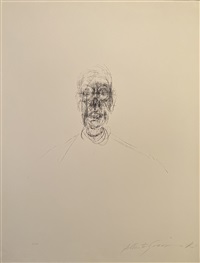Alberto Giacometti
(Swiss, 1901–1966)
Biography
Alberto Giacometti was a Swiss artist known for his totemic sculptures of elongated human figures. Giacometti established himself through works such as Head-Skull (1934), which explored psychology and death through stylized forms. “All the art of the past rises up before me, the art of all ages and all civilizations, everything becomes simultaneous, as if space had replaced time,” he once mused. “Memories of works of art blend with affective memories, with my work, with my whole life.” Born in Borgonovo, Switzerland on October 10, 1901 to a family of artists, including his father the Post-Impressionist painter Giovanni Giacometti and his brother the sculptor Diego Giacometti. He went on to study painting and sculpture at the École des Arts Industriels in Geneva before moving to Paris in 1922. In Paris, he studied sculpture under Antoine Bourdelle and befriended Surrealists Man Ray, Joan Miró, and André Breton. Following the horrors of World War II, the artist became fascinated by his friend Jean-Paul Sartre’s Existentialist writings, and began his seminal Walking Man series of sculptures. By the 1960s, Giacometti had achieved worldwide recognition, receiving the top prize at the 1962 Venice Biennale and a major retrospective at The Museum of Modern Art in New York in 1965. He died on January 11, 1966 in Chur, Switzerland. In 2015, the artist’s Pointing Man (1947), sold at auction for a record-breaking $142.8 million. Today, Giacometti’s works are held in the collections of the J. Paul Getty Museum in Los Angeles, the Tate Gallery in London, the Solomon R. Guggenheim Museum in New York, and the Kunsthaus Zürich, among others.
Most Expensive Artwork Sold at Auction
Alberto Giacometti
(6,140 results)

![[1] Tenailles dans l'atelier de Diego [2]..., 1965 [1] Tenailles dans l'atelier de Diego [2]..., 1965](http://www.artnet.com/WebServices/images/ll00099lldD77JFgxtkR3CfDrCWQFHPKc113G/alberto-giacometti-[1]-tenailles-dans-latelier-de-diego-[2]-coin-de-latelier-de-diego-i--[3]-coin-de-latelier-de.jpg)


![Femme assise [Aika], 1960 Femme assise [Aika], 1960](http://www.artnet.com/WebServices/images/ll00042lldx67JFgUUECfDrCWQFHPKc9k3G/alberto-giacometti-femme-assise-[aika].jpg)






.jpg)









.jpg)
.jpg)
.jpg)
